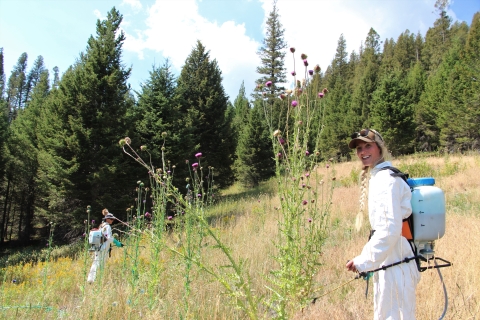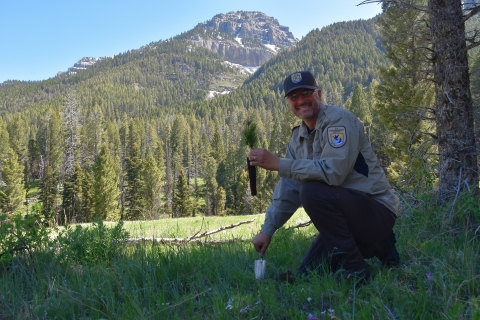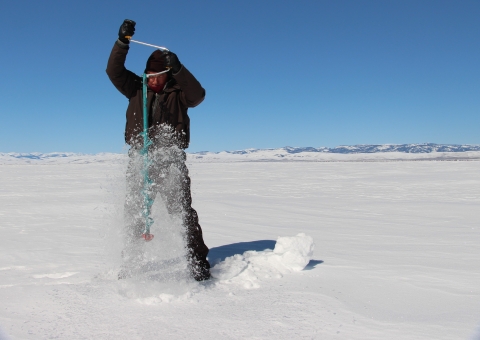Projects and Research
Wilderness Stewardship
A large part of Red Rock Lakes National Wildlife Refuge is designated wilderness. As we carry out our fieldwork, we consider the impacts of our activities and how we can preserve wilderness character. To access wilderness areas for fieldwork, we travel on foot, on skis, or in canoes and kayaks to preserve the values of the Refuge wilderness.
Ecological Restoration
The Refuge is a wild place in a remote location, but even here human activity impacts the landscape. Management of the Refuge includes removing the marks left by past generations and building ecosystem resilience.
Invasive Species ControlThe Centennial Valley is an especially remote place with fewer vectors for invasive species invasive species |
Grassland RestorationFive acres were restored in a field formerly inundated with invasive grasses at Red Rock Lakes National Wildlife Refuge. Eight species of native grasses and twelve species of native flowering forbs combining with some already present native forbs are expected to provide improved habitat for pollinators, birds, and mammals. In addition to returning this field to its fully functioning ecosystem state, it may also serve as an environmental education and interpretive site. |
Aspen ReforestationVolunteers, technicians, and Refuge staff planted over 2,000 aspen tree seedlings in two exclosures totaling nearly five acres in size at a Refuge timber improvement project site to facilitate Wildland Urban Interface and to accomplish the Refuge's aspen reforestation goal outlined in its Comprehensive Conservation Plan. The timber improvement project will help mitigate wildfire dangers near the Refuge headquarters. Aspen seeds were hand collected from different mother trees around the Refuge and atop Red Rock Pass, then propagated into seedlings by the Montana Dept. of Natural Resources and Conservation tree seedling nursery. Many thanks to all who volunteered their time and efforts on to plant tree seedlings at Red Rock Lakes National Wildlife Refuge. |
Whitebark PineThe range of the endangered whitebark pine (Pinus albicaulis) extends throughout the Greater Yellowstone Ecosystem, including the mountainous areas of Red Rock Lakes. We partnered with the Montana DNRC tree seedling nursery, by collecting cones filled with seed, which they propagated into seedlings for subsequent planting to help this important keystone species persevere. |
Monitoring and Management
PollinatorsThe state of Montana is home to over two dozen native bumblebee species, many of which make their home in the Centennial Valley. A few particularly interesting species have been documented on the Refuge, including the Western bumblebee (Bombus occidentalis) and Suckley's cuckoo bumblebee (B. suckleyi). We plan to continue monitoring for these species and others in partnership with The Xerces Society for Pollinator Conservation. |
Willow BrowseTechnicians identify different species of willows and perform browse surveys to assess the level of moose herbivory, its effect on overall willow community health, and subsequent ecosystem effects. Data collected will help assess browse pressure exhibited by moose. Willows provide important habitat for songbirds and winter food resources for several ungulate species, so understanding browse impact is important in determining willow community health. |
Carnivore InventoryThe Refuge has several carnivore species inhabiting its many different habitat types. We use non-invasive means to document these elusive creatures. |
Bluebird TrailThe Refuge bluebird trail is at over 90 nest boxes and 18+miles long. With invasive bird species like European starlings and English sparrows often outcompeting native bluebirds for natural nest sites, the Refuge’s bluebird trail takes on an increased importance. Volunteers and seasonals monitor nestling development and record survivorship, species composition, and timing of fledging each year. |
Arctic Grayling Adaptive Management Plan
Red Rock Lakes is home to a population of Arctic grayling (Thymallus arcticus) that have been experiencing a steep decline in recent years. The U.S. Fish & Wildlife Service has formed a partnership with Montana Fish Wildlife & Parks to monitor and manage the fish population and habitat in the lakes and streams throughout the Centennial Valley in SW Montana. Researchers and biologists from both organizations have worked together to try and determine the factors affecting the species' decline and to develop a plan of action to support these fish through habitat projects and partnerships with landowners.
Winter HypoxiaUpper Red Rock Lake, which only 6 feet at its deepest point, is important winter habitat for grayling. When the first few feet on the surface of the lake freeze, this leaves less available water from which the fish can extract oxygen, a condition called hypoxia. Hypoxic conditions are thought to be a contributing factor in the decline of the Arctic grayling population, so researchers measure ice depth and dissolved oxygen levels at different depths to determine the amount of suitable winter habitat available from year to year. |




